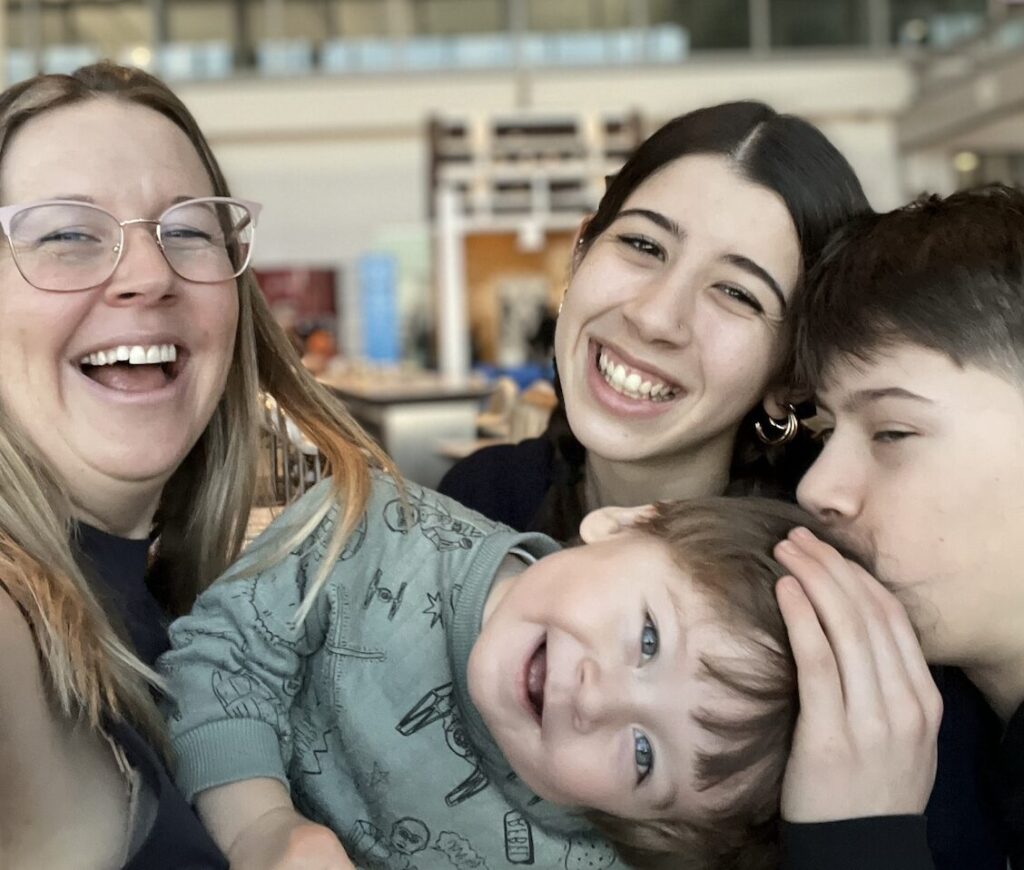 When Jo-Anne Peckham distributed owl
When Jo-Anne Peckham distributed owl
pellets among her students to dissect, she
hoped that they would, at best, extract a few
bones from the regurgitated remains of the
owl’s meal, and at worst, not devolve into
a pellet flinging contest. She needn’t have
worried. With furrowed brows, the kids were
soon teasing out small skeletal pieces from
the egg-sized clumps then comparing each
find against a chart to classify bones by their
scientific terms. What made this situation so
unique was that it was taking place in a class
full of kindergartners.
“These children were using advanced
terminology, like scapula and mandible, and
recreating entire skeletons of animals with
one another’s bones,” says Jo-Anne. While
most five-year-olds are practising how to use
scissors and glue, she has spent the last couple
of years encouraging the school’s youngest
students to develop investigative techniques
using real life problems.
“I would rather let kids discover their answers
on their own,” she says. “To experience
their own Aha! moments.”
It is this process of coming up with questions
and exploring solutions that provides
the foundation for innovative thinking – a
buzz phrase that generates images of high
tech superstars like Apple creator, Steve Jobs,
and Blackberry creator, Jim Balsillie. Technology
and science are playing an increasingly
ubiquitous role in daily life, from robot
vacuums to cutting edge medical treatments.
Governments around the globe are touting the
importance of building a culture of innovation
to help solve the world’s most pressing
problems.
We also need to compete in an era where
the potential to develop new ideas seems as
limitless as cyberspace itself. For Canada’s first
generation of the 21st century, the road to becoming
the technological leaders of tomorrow
starts long before they earn their university
degrees.
Many parents remember science class as a
mandatory hour of the day where they fought
to keep their eyes open during lectures on the
periodic table. Brainiac straight-A kids thrived
(and stayed awake), while everyone else
muddled through until the day arrived when
they’d never again have to look at a chemical
formula. Yet for their own children, whose
lives are interwoven with technology, that
mentality to “just get by” in the classroom lab
is a risky proposition.
The definition of innovation is, very simply,
the ability to provide a new idea and make
it useful. Innovation has propelled society
forward – sometimes in leaps – for centuries,
such as the progression from telegraph to telephone
to smartphone. What will come next?
Undoubtedly, the children who cultivate an
appreciation of science and a desire to innovate
will have that answer, and many more.
But how does a parent, who is more comfortable
explaining a slapshot than the theory
of relativity, teach a child to be innovative? The
surprising answer, and one that is slowly taking
shape in schools across Canada, is to let the
child take the lead in exploring.
Feed a child’s natural curiosity
Every child comes naturally equipped with
an insatiable curiosity that spills out in a
steady stream of questions. Why don’t dogs
have eyebrows? How do lightbulbs turn off?
What makes pop fizz? Yet as they grow older,
the questions invariably decrease, and may
eventually stop altogether.
It doesn’t have to be that way, says
Reni Barlow, executive director
of Youth Science Canada, an
organization that encourages
scientific inquiry in the classroom
and science fairs across the country.
“Parents do not need a background in
science to help kids become interested in
science. They just need to be supportive of the
process of inquiry. When kids ask questions,
parents can engage them by asking ‘how do
you suppose you could find the answer?’”
Opportunities to discuss the wonders of
science pop up during walks to school, while
preparing meals, and even cleaning the
house (it never hurts to encourage a child do
chores). Too often, parents hastily respond
to a child’s question with little thought or
wave it away for another time (especially if
they don’t have the answer). Not surprisingly,
this may eventually extinguish the spark
of curiosity that is so essential to nurturing
inventive thought.
A fair for young scientists
Schools play a pivotal role in helping build
upon a child’s innovation foundation.
Science class is an ideal springboard since
the scientific inquiry technique is also
rooted in the process of asking questions. Dr.
Johanne Patry understands the challenges of
engaging young minds in science. A recipient
of the Prime Minister’s Award for Teaching
Excellence and Europe’s Science on Stage
Award, she is Chair of Science on Stage
Canada and a trailblazer in transforming
science classrooms from drill-and-kill style
teaching to hands-on learning.
“Children need to learn beyond the
textbook,” says Dr. Patry. “Science is action
and elementary students should be learning
about exploring.” She has heard this method
described as “teaching with your hands
in your pocket” as it requires teachers to
surrender some of their control so kids can
lead their own scientific discoveries. She
concedes that many teachers resist this
style for fear of the chaos that may erupt,
or explode, when a couple dozen primary
students are allowed to perform their own
experiments.
Yet that’s exactly the philosophy behind
the long-running tradition of science fairs
that crop up across the country every spring.
They introduce thousands of young scientists
to the thrill of the Eureka! moment. Unlike
classroom science, where each lesson tends to
focus on a single skill or technique, a science
fair empowers a student to feel what it’s like
to be an actual scientist.
“A science fair project addresses that
whole project connectedness by letting kids
ask their own question, make their own
procedure, try it out and maybe (or maybe
not) get the answer they wanted. Just the way
real science works,” says Danielle Gauci, cochair
of the Toronto Science Fair and a science
teacher of 10 years. She has seen a wide range
of projects over the years and insists the key
is not so much the question that a student
generates, but rather the experience he or she
gains from learning the process of scientific
inquiry. The more students can apply their
scientific learnings to real life, the more likely
they are to stay interested in a topic that has
traditionally been seen as a one-way ticket to
geekdom. A stereotype, in fact, that is slowly
disintegrating.
“People assume the participants will be
really ‘nerdy’ kids, but many of them are
incredibly well-balanced,” says Reni Barlow,
who believes the broadening interest in
science is more necessary today than ever
in a world increasingly reliant on scientific
information for day-to-day tasks.
Says Reni, “Regardless of whether you
pursue a career in science, everybody should
have an understanding of how science
happens and how things work.”
Bring the science fair to class
For all the thousands of students who
participate in science fairs, there are still
thousands more who don’t because they don’t
have the resources – or that one passionate
science teacher – to prepare students for fair
participation. Mike Newnham is the cofounder
and director of Smarter Science, a
program for teaching science from Grades 1 to
12 that develops the skills of inquiry, creativity,
and innovation. He is hoping to even the
playing field for all of Canada’s schools.
“Instead of thinking of the science fair
as an added component, make it part of the
classroom,” says Mike. Since 2008, Smarter
Science has trained Ontario teachers in
strategies that teach kids problem solving and
critical thinking skills using scientific inquiry,
and was the inspiration that led to Jo-Anne
Peckham’s owl pellet lesson. As it expands
its reach to Prince Edward Island and British
Columbia, Mike emphasizes that the goal of
Smarter Science is simple: “To make sure that
every child in Canada performs one inquirybased
project each year.”
Parents, however, might assume that
just because their child’s teacher has been
trained in Smarter Science, their school
has implemented it. The choice to adopt the
program is left to each individual teacher,
some of whom may be resistant to change.
Thankfully, innovative science instruction
needn’t be confined to the school lab any more
than sport is confined to the gymnasium.
Science-based extracurriculars
While signing kids up for arts or sports is
a no-brainer for North American parents,
extracurricular science-based clubs aren’t
necessarily on their radar. David Ellis,
Director of First Robotics Canada, regularly
witnesses parents’ excitement when they
learn about the volunteer-run national
organization in which kids program and
design a Lego robot that solves real-world
engineering challenges. It culminates in a
year-end competition often referred to as the
“SuperBowl of Smarts.” It is one of a growing
number of organizations offering cerebral
alternatives to the usual smorgasbord of afterschool
activities. And it’s not just the Einstein
wannabes who are lining up to join.
David saw 60 students try out for his
school’s 10-member team this year. “It works
with all kids because you have drama, literacy,
creativity, science and math, along with the
competitive side of the program.”
Whether a child learns innovation through
home, school or a club, the message is
consistently one of empowerment. If a child
is not only encouraged to ask questions, but
given permission to make mistakes in finding
the answers, the seed of innovative thinking
will naturally blossom.
Today, Jo-Anne Peckham teaches Grade 7
and 8 students who did not have the benefit of
Smarter Science in kindergarten. She notices
one difference: “It’s harder to get them to ask
the questions.”
Danielle Leonard is a mother of three boys whose science
experiments leave her kitchen in a constant state of disaster.
She lives in Oakville where she blogs about parenting in the
digital age at Porridgereport.com.
Originally published in ParentsCanada magazine, November 2012.









